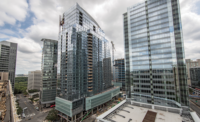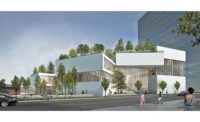When PMC Property Group decided to redevelop a 350,000-sq-ft former industrial building at 2400 Market Street in Philadelphia and add 300,000-sq-ft of office space above it, they knew they stood on solid footing. The massive concrete facility built around 1920 was originally designed as an automotive warehouse. It was designed to handle heavy loads, but the space, built on a diagonal grid with large interior ramps for moving vehicles throughout the building, didn’t lend itself to office or retail use. To integrate construction with the existing building required numerous structural upgrades, including transferring, removing and retrofitting columns that were approximately 100 years old.
“It was so structurally sound, it was no problem adding five stories,” says Jay Persico, project manager at Fastrack, PMC’s project-management arm. But Persico notes that the team did need to add a new column grid on top, to normalize the pattern.
The final design calls for mixed commercial space in the original five-story concrete building, topped by five new floors of structural-steel commercial office space. When completed later this year, that area will be occupied entirely by Aramark. Each floor covers roughly 60,000 sq ft, allowing for large open spaces, as needed. The original building features 15-ft floor-to-floor ceiling heights, which are repeated in the new space. The team, which declined to disclose the project’s cost, includes design firms Gensler and Varenhorst.
“The existing building could take the dead load, but not the lateral load, so we had to add two cores to address that,” says Stephen Varenhorst, president of Varenhorst, which serves as executive architect.
The building sits on spread footings that bear on rock 14 ft below grade. The project team removed the original cores and constructed two new lateral cores that sit on mat foundations supported by hundreds of micropiles. The design also calls for inserting a 6,000-sq-ft atrium.
To create the cores, crews shored the existing slab, then made oversized cuts to accommodate formwork. Creating the new openings in the slabs, which measured about 30 ft by 25 ft per floor, required removing one existing column from each floor per core. Shear walls were formed and placed. Then formwork was removed and a continuous concrete corbel was installed off of the walls to support the existing floor slabs. The corbel ties the old building into the new shear walls for gravity and lateral support.
The existing concrete structure is laid out in a diagonal grid pattern—called a Morrow System—with bay spacing of roughly 30 ft squared. The system features round 40-in.-dia columns topped by large capitals. To make connections to the round columns, the team at Harman, the structural design firm, devised two types of connections.
On about half of the existing columns, steel beams are connected to existing round columns with large collar plates fastened with adhesive anchors. Connections could not be made at the top of the columns because of the large capitals that flare out as they meet the slab above. Instead, collar plates jacket the bottom of each concrete column. New steel tension rods, welded to the plates, pass from the plates through the floor slab so that new steel could be hung below.
The jacketing system required thousands of adhesive anchors, all of which had to be detailed, says Lea Cosenza, an associate at Harman.
“We had to work closely with the steel fabricator and steel erector,” Cosenza says. “In some places, they couldn’t get an anchor in because the rebar was too packed together, so they needed [the anchor locations] moved.” She adds, “It was a lot of work to get those adhesive anchors in.”
On the top floor of the five-story building, the team was unable to use the same connection system because there was nothing above to support it. Instead, crews cut out the capitals and added steel plates to the top of the existing cut columns so that new steel beams could be installed above them. When capitals were cut, half of the steel structure was already in place. To erect the new steel transfer girders, shoring was designed to support the steel columns above. From there, the team could add the new five-story steel structure.
“The load comes through those girders back into the concrete columns all the way down, supporting the entire overbuild,” Cosenza says.
As future tenants signed on, new structural demands arose. The Fitler Club, a private lifestyle club, which will occupy parts of the ground, first and second floors, asked for a mezzanine floor to be added. The new level is supported by a continuous shelf plate that attaches to existing columns with collar plates affixed with adhesive anchors. The existing slab on grade was dug out and lowered to better accommodate the new layout.
The club also requested an event space on the ground floor with a large column-free area. An existing column needed to be removed, but Cosenza says the request was made after Aramark’s new overbuild was nearly complete and that column was supporting all 10 floors. “We had to grab Aramark’s steel from the fifth floor without it deflecting and cracking,” she recalls. “We picked up the column that was supporting the overbuild, transferred that out and picked up every floor after that.”
Two new 50-ft-long, 6-ft-deep steel trusses were installed. They support a steel transfer girder that carries the column supporting the floors above. Cosenza says the team devised a truss solution because it could be built in the field with bolts, instead of welding. The trusses also supported temporary shoring columns installed on the floors above.
Besides integrating old and new structures, the design team wanted to integrate the building’s overall exterior appearance with a new unitized curtain wall system. Varenhorst says that while the new construction lined up well for hanging curtain wall, the existing building wasn’t so precisely aligned.
“It was shocking how much out of alignment it was in some places,” he says. “It wasn’t structurally unsound, it just wasn’t aligned. Some columns were nearly 2 feet off. It was a real challenge to bring that skin down over the existing building.” He adds, “We had to find the worst condition and design to that. In some places, it’s tight to the building and some places it’s 18 inches away with infill added.”
To let in more natural light and improve views of the neighboring Schuylkill River, crews cut existing spandrels where possible to allow floor-to-ceiling glass.
Although the building fills an entire city block between the major thoroughfares of Market and Chestnut streets, the river facade is considered the building’s main entrance. A steel structure promenade cantilevers up to 25 ft from the existing building. The river facade is also adjacent to a CSX rail line, so new foundations couldn’t be used for the promenade. Instead, the team attached steel plates to existing concrete columns with adhesive anchors. The cantilevered beams are then braced to the columns.
Throughout the existing building’s renovation, crews had to work around two tenants that remained, including a server farm that couldn’t be disrupted. The server farm’s location also required transferring a beam that couldn’t penetrate the space because the servers had to be in continuous operation. “That required a ton of shoring all the way up the building and was a time-consuming process,” Persico says.
Work on the building’s existing portion was split into thirds. The team realized that demolition of the middle third would take longer than the other sections would, so work was sequenced to start on the south end, then shift to the north end and finish in the middle. “We didn’t have time for the normal sequence,” Persico says. “We tied those two ends together in the middle and went up from there. We had to make some adjustments in the field but for the most part, everything came out as drawn.”
One of existing structure’s advantages was its large, sturdy roof. “We were able to stock tons of steel on the roof as we built it,” Persico says. “We could never do that anywhere else. That’s how strong this building was. It basically gave us 60,000 sq ft of laydown on the roof.”









